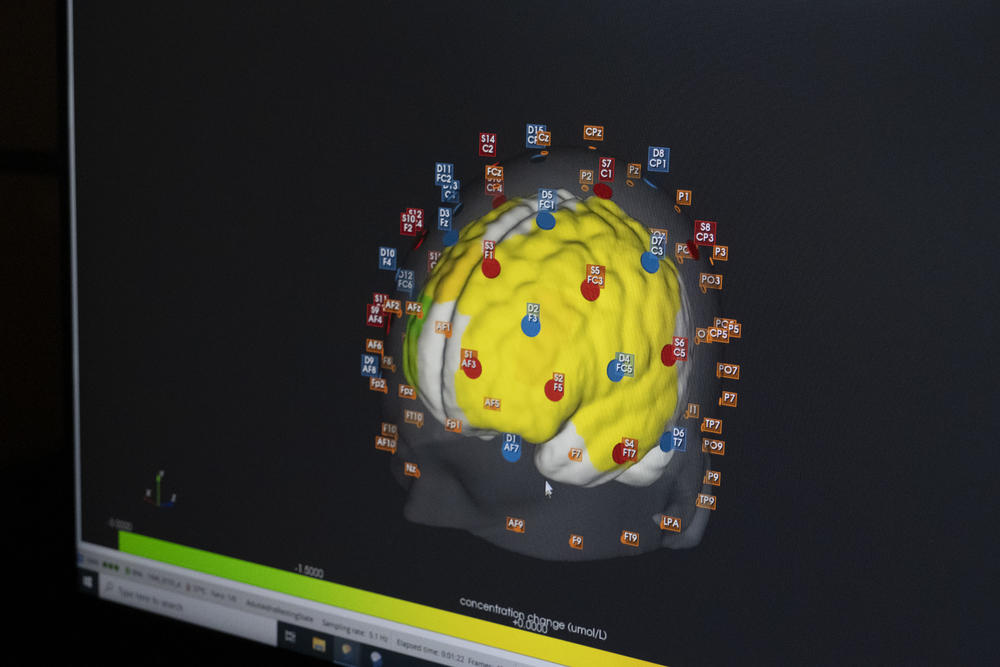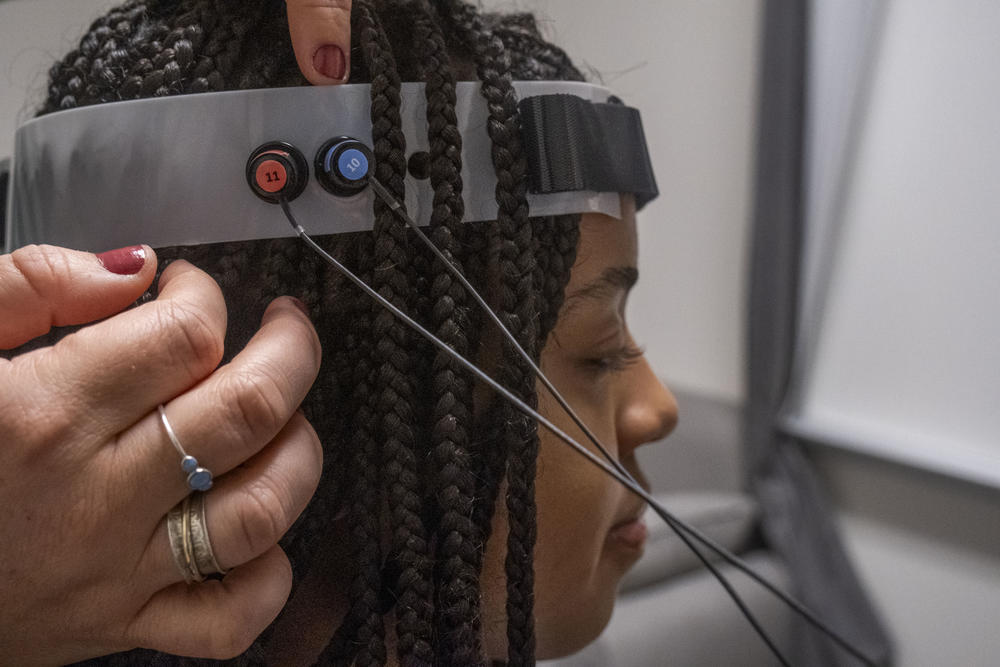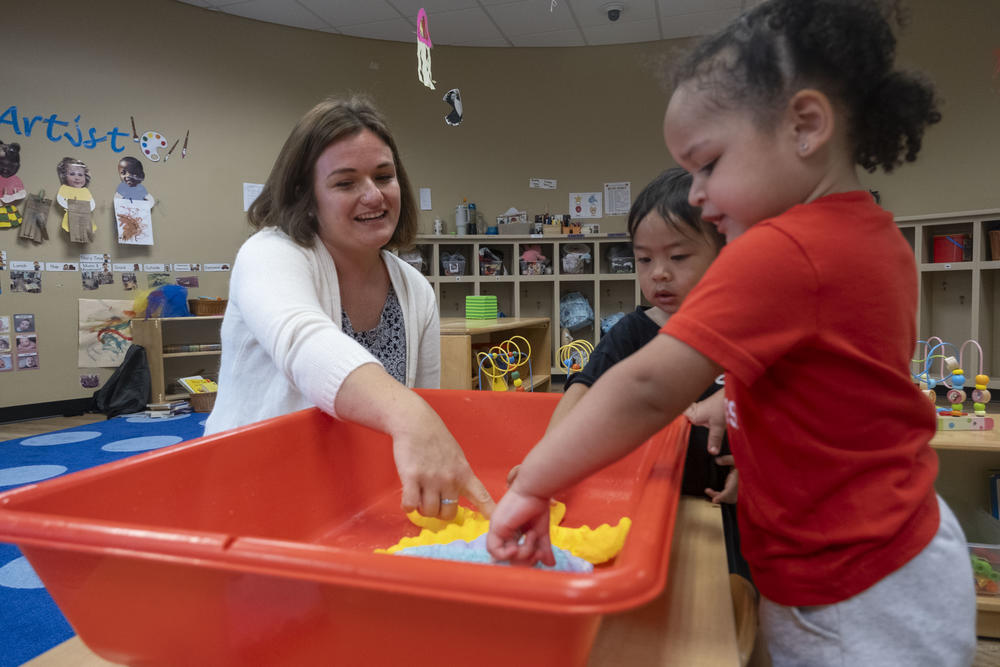
Section Branding
Header Content
Scientists have cutting edge technology to scan kids' brains. But it wasn't built for all heads
Primary Content
LISTEN: How a Middle Georgia researcher is working on making brain scanning technology more accessible. GPB's Sofi Gratas reports.

At a Mercer University lab, students are watching each other’s brains at work.
Grace Gasaway works on fitting a functional near-infrared spectroscopy cap — fNIRS for short — on to another classmate’s head. It looks like a swim cap covered in empty spools of thread.
Each empty spool is actually a detector measuring brain activity through an infrared light signal.
The signals are read on a computer.
“The green indicates that the signal is good, and the red indicates obviously, the signal is bad,” Gasaway explains.
Once on, the cap allows Gasaway and her classmates to see a 3D image of fellow student Parth Patel’s brain and its blood flow.
But there’s a problem. Patel’s hair is really dark and really thick. On the screen, there’s a lot of red and yellow, indicating a poor connection with his scalp.
“Obviously it’s not a good detector because there's all this hair in the way,” Gasaway said, pointing to a detector blinking red. “And this is what takes a while.”
It takes moving that hair with a Q-tip, one detector at a time, to get a good connection.
While the students in this lab are in college, fNRIS is optimized to study brain activity in younger subjects, said neuroscientist Anastasia Kerr-German, who runs the research happening here.
“We can't stick a kid in an fMRI scanner in a wakeful state until they're a healthy 6 or 7 years old because they won’t sit for it,” she said.
Kerr-German is an assistant professor at Mercer University in the Department of Psychology and has been working for years in developmental cognitive neuroscience, trying to understand how kids’ decision-making and brain activity changes over time.
By the time kids can sit in an MRI machine, researchers may have missed a crucial window for understanding how conditions like ADHD and autism develop.
Using fNIRS has helped study those younger kids, with an exception.
“Now we've found that you can't use it with any little kid that has any kind of hairstyle outside of flat, straight hair,” said Kerr-German.
That’s the hair most white kids have, meaning this cutting-edge research has so far largely left out Black and brown kids.
While children don’t need to have their brains scanned to diagnose the root causes of atypical behaviors, making this technology accessible to everyone is necessary if researchers want an accurate understanding of childhood development.
“It is very difficult to generalize a really biased demographic sample to the general population,” Kerr-German said. "Part of that is we aren't diagnosing children of color as often. And that's a separate prong sort of issue that we're addressing in this lab. But then part of that is, even if we could find them and diagnose them, our technology won't even scan them."
And already, there are prejudices rooted in children’s mental health.
According to national data from the Centers for Disease Control and Prevention, white boys are more likely than others to be diagnosed with ADHD. A diagnosis can lead to support. Meanwhile, Black boys more often get labeled with behavioral issues and receive no intervention or may be punished.
Kerr-German wants to see these trends change.
“The lowest-hanging fruit, in our opinion, is to address the disparities based on race in this technology,” Kerr-German said.
So, for the past few months, Kerr-German and her students have been working on creating a more inclusive type of fNIRS cap.
For now, the prototype involves flexible plastic used to weave the detectors onto a participant's head. It’s affordable to recreate — about $300, Kerr-German estimates — and the lab hopes to get this model approved for use across the country. The group will present a prototype at an international conference later this year.

Kerr-German isn’t the first to raise these questions about accessibility in fNIRS technology, and there have been other efforts to make this technology fit course, curly hair and protective hairstyles like braids or locs.
Yet, the most commonly used fNIRS technology is still the traditional cap. And there are ongoing concerns, even among adults, about accessibility to the so-called electroencephalogram tests that measure brain activity.
Mercer student Alexandria Shells, also working in the lab, says it will take more than just fixing the technology to reach populations currently excluded. Shells is Black, and recognizes mistrust runs deep.
“We’re very protective, I think — as we should be; a lot of harm has been done to our community, especially coming from research institutions,” Shells said. “I think our biggest goal with this project is, like, helping build trust.”
At the Child Development Center at Central Georgia Technical College, Kerr-German has been welcomed to start building that trust.

During her first visit to the center in Warner Robins, just south of Macon, Kerr-German moves around a classroom of preschoolers, playing with them but also watching for any signs that a kid may need extra support for a possible developmental disorder.
Director at the center, Brett Copeland, said some parents are reluctant to address what their child may be experiencing, even if they have a feeling that something “isn’t on track.”
“I think families come in with a variety of understandings and levels of acceptance,” Copeland said.
Having Kerr-German visit and build a dialogue with families can help.
“It is the combination of credentials and relationships that open doors to acceptance and treatment options,” Copeland said.
Kerr German will share what she sees with parents in the hopes that information can help a child succeed.
“We also hopefully will be building bridges to where these communities want to then come be a part of research,” Kerr-German said.
It’s a first step, she says, but a big one toward more inclusive science.


